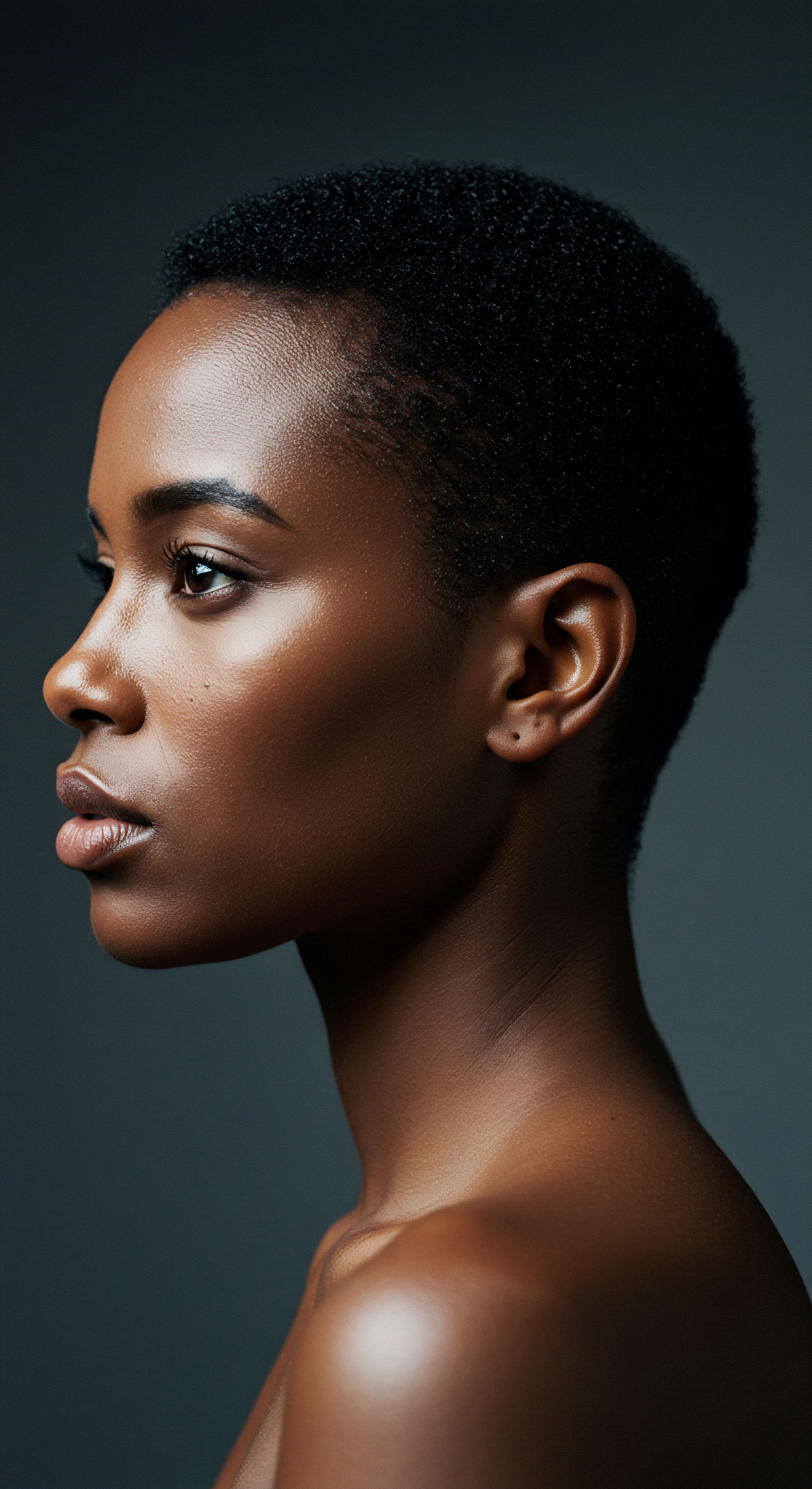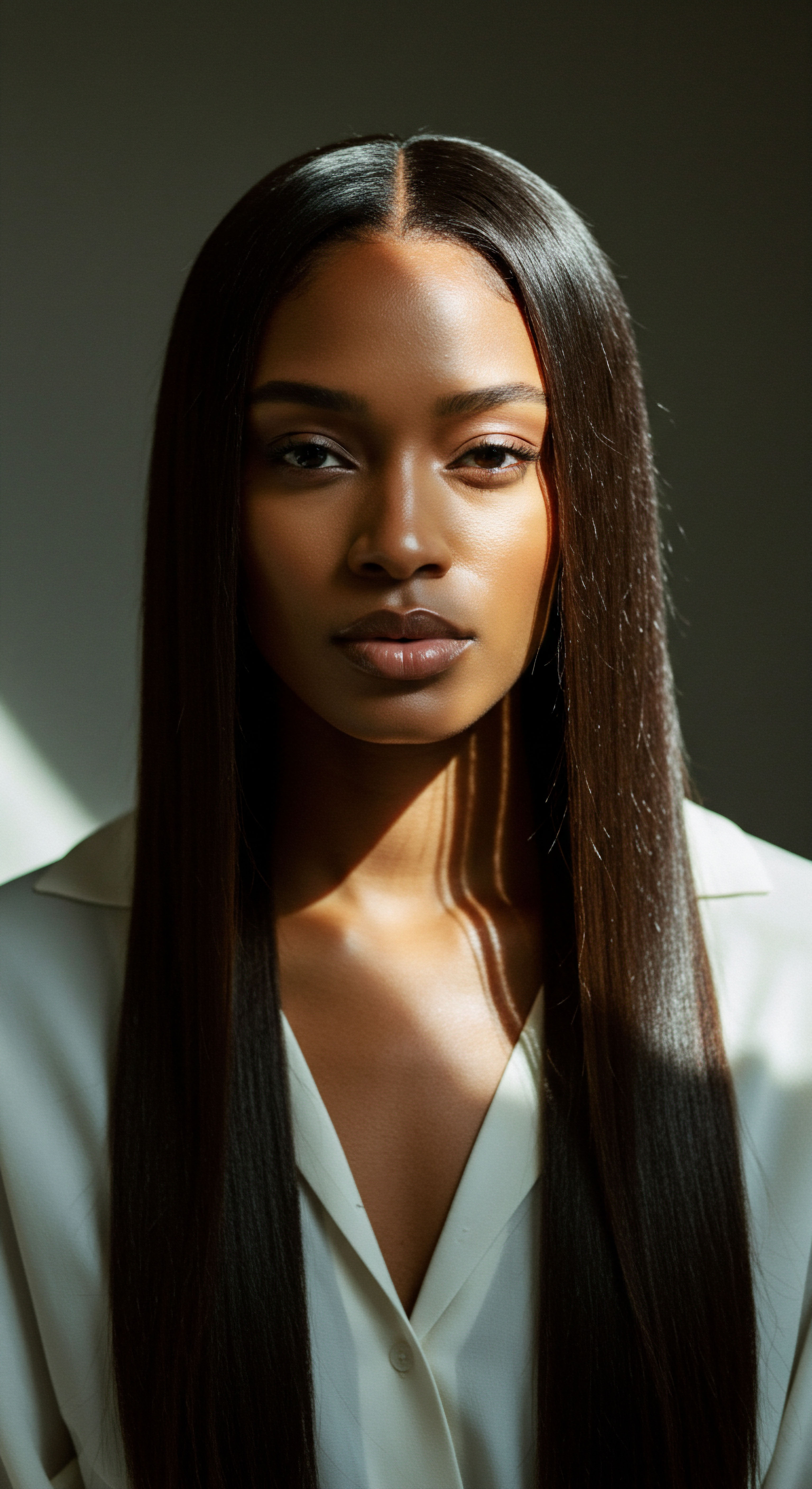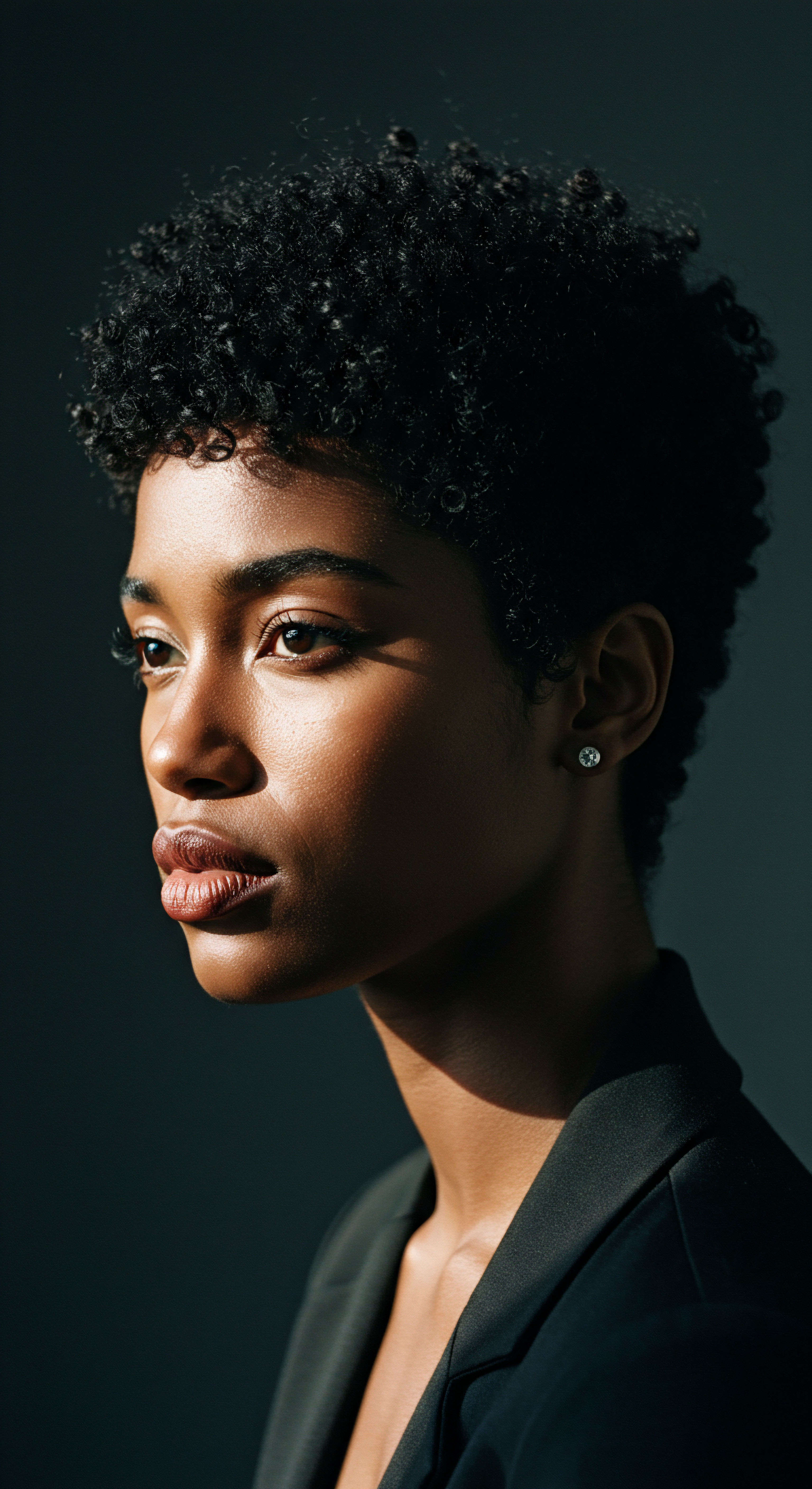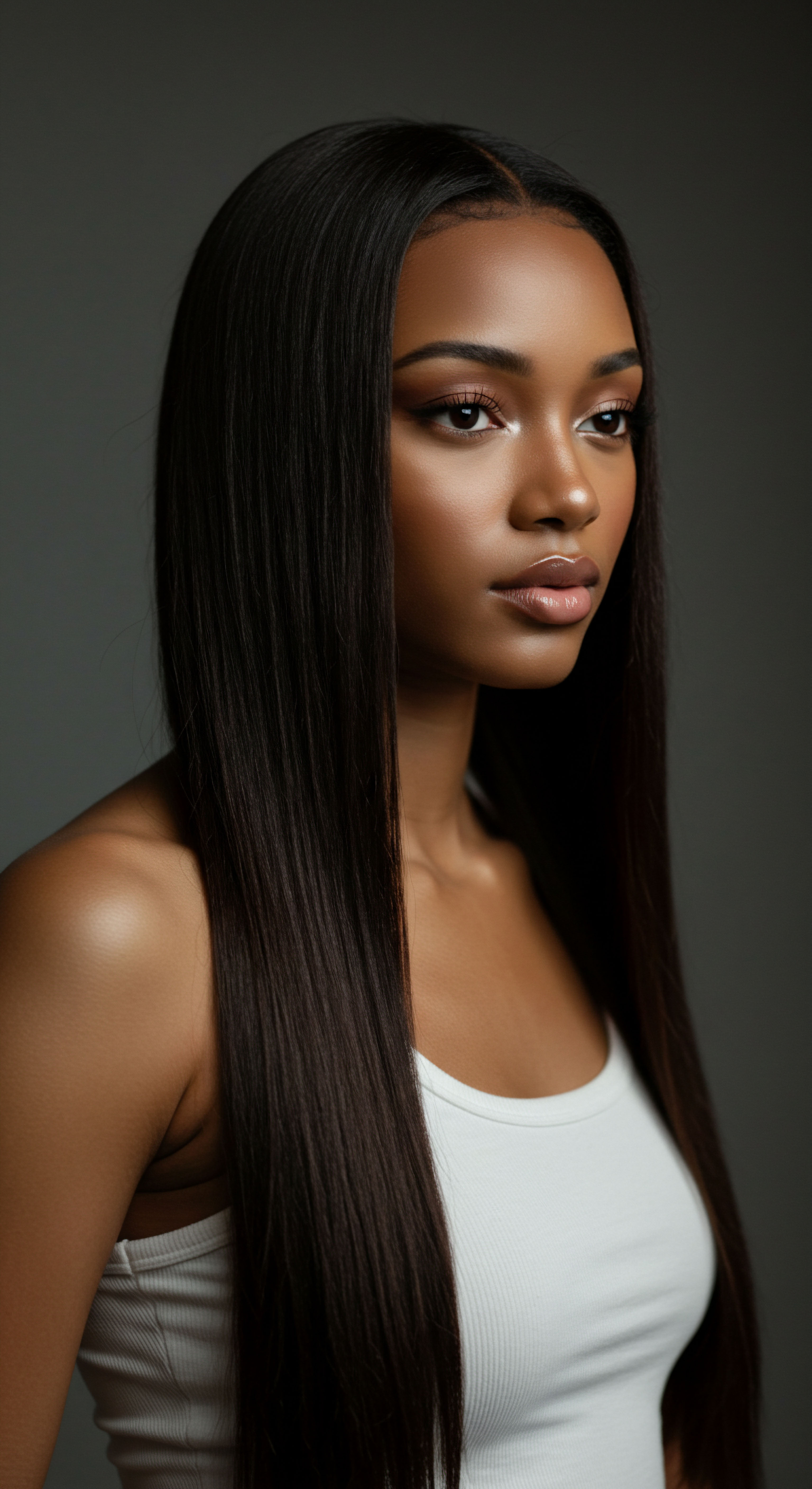
Roots
A quiet observation, often made without conscious thought, might be how different strands of hair, even those growing from the same scalp, seem to hold onto life-giving moisture with varying degrees of tenacity. This gentle curiosity leads us to the very genesis of each strand, deep within the scalp, where the shape of the hair follicle itself orchestrates a silent, profound influence on how a hair strand interacts with water, a relationship so fundamental to its vitality. To truly comprehend the symphony of strand hydration, one must first listen to the whispers of the follicle, for it is here, at the root, that the initial notes of moisture retention are struck.

Anatomy of the Hair Follicle and Its Shape
The hair follicle, a microscopic organ residing within the dermis of the scalp, is far more than a mere anchor for the hair shaft. It is a dynamic factory, shaping the very architecture of the hair as it emerges. The cross-sectional shape of this follicle dictates the geometry of the hair fiber it produces. When the follicle is perfectly round, it gives rise to straight hair with a circular cross-section.
As the follicle assumes an oval or elliptical contour, the hair strand it forms becomes flatter, ribbon-like, or even highly coiled. The more pronounced the oval or the more asymmetrical the follicle, the tighter the resulting curl pattern on the head. This architectural blueprint, established at the follicular level, carries significant implications for the strand’s ability to retain hydration.
The hair follicle’s cross-sectional shape dictates the strand’s geometry, directly influencing its inherent capacity for moisture retention.
Consider the hair shaft itself ❉ it comprises three primary layers. The innermost, the medulla, is often absent in finer hair. Surrounding this is the cortex, a dense region of keratin proteins responsible for the hair’s strength and elasticity, and crucially, its primary site for water uptake.
Encasing the cortex is the cuticle, the outermost protective shield composed of overlapping, scale-like cells, much like shingles on a roof. The arrangement and integrity of these cuticle scales are paramount in regulating how water enters and exits the hair.

The Angle of Growth and Sebum’s Journey
Beyond the cross-sectional shape, the angle at which the hair follicle emerges from the scalp also plays a silent yet significant role. Straight hair follicles typically descend straight down into the skin, allowing for a relatively unimpeded path for sebum, the scalp’s natural conditioning oil, to travel down the hair shaft. However, in the case of textured hair, the follicle often points down at an angle, sometimes even forming an S-shape or a spiral. This angled growth creates a challenging path for sebum.
The natural oils produced by the sebaceous glands, which are microscopic glands connected to the hair follicles, struggle to navigate the numerous twists and turns of a curly or coily strand. This physical impediment means that textured hair often receives less natural lubrication from the scalp’s own conditioning system, making it inherently more susceptible to dryness. This anatomical reality underscores why external hydration strategies become not merely beneficial, but truly vital for textured hair types.

Porosity and Cuticle Configuration
The term ‘porosity’ refers to the hair’s ability to absorb and retain moisture, a characteristic directly linked to the cuticle’s condition. In strands with a more circular cross-section, the cuticle scales tend to lie flatter and more tightly bound, often indicating lower porosity. Such hair resists water entry due to this smooth, compact surface, yet once moisture penetrates, it is held within the strand for a longer duration.
Conversely, hair emerging from oval or highly curved follicles, characteristic of textured hair, often presents with cuticle scales that are naturally more raised, or even possess small gaps. This configuration leads to higher porosity, allowing water and products to enter the hair shaft with greater ease. While this might seem advantageous for absorption, the very openness that permits entry also facilitates rapid moisture loss.
This explains why highly textured hair can absorb water quickly, yet feel dry shortly thereafter. This inherent structural difference, rooted in the follicle’s original shaping, is a primary reason why managing hydration in textured hair presents a unique set of considerations.
- Follicle Shape determines the strand’s cross-sectional form, influencing cuticle arrangement.
- Angled Growth impedes natural sebum distribution along curly and coily strands.
- Cuticle Openness dictates hair porosity, affecting moisture absorption and retention rates.

Ritual
Stepping into the realm of daily care, one might reflect on the intentional practices that transform hair from a biological structure into a living expression of self. The wisdom we apply in our hair rituals, from the selection of products to the gentlest touch, directly interacts with the intrinsic characteristics gifted by the hair follicle’s shape. This section offers a gentle guide through the practical applications of understanding hair’s thirst, moving beyond simple steps to a deeper appreciation of why certain routines resonate so profoundly with textured hair.

How Do Styling Choices Affect Hydration?
The choices made in styling play a considerable role in how well a hair strand maintains its hydration, particularly for those with textured hair. When hair strands are tightly coiled, the mechanical stress of styling, such as detangling or brushing, can place significant strain on the hair’s structure. A study conducted on curly hair reveals it requires a notably higher combing force compared to straight hair, ranging from 5 to 50 times more. This increased force can lift or damage the cuticle, thereby increasing the hair’s porosity and accelerating moisture loss.
Protective styles, which tuck away the hair ends and minimize manipulation, serve as a sanctuary for hydration. Styles like braids, twists, or buns reduce exposure to environmental stressors and mechanical friction, allowing the hair’s natural moisture to remain within the shaft for longer periods.
Conversely, styles that involve frequent heat application, such as straightening or blow-drying without adequate protection, can compromise the hair’s lipid barrier and cuticle integrity. Heat can temporarily open cuticle scales, and excessive or repeated heat can cause permanent damage, leaving the hair vulnerable to dehydration. Even the seemingly innocuous act of air-drying without proper sealing can lead to moisture evaporation, particularly in porous, textured hair. Understanding the physical demands placed upon hair by different styling methods, and selecting practices that respect its inherent structural vulnerabilities, becomes a guiding principle for preserving its precious water content.

The Role of Product Selection and Application
The selection of hair care products must align with the hair’s unique hydration needs, which are, in turn, informed by its follicular shape. For hair with tighter curls and coils, which naturally experiences slower sebum distribution, products rich in emollients and humectants become particularly beneficial. Emollients help to soften and smooth the cuticle, reducing friction and aiding in moisture retention, while humectants draw water from the environment into the hair shaft.
The method of application is equally important. Distributing products evenly, especially conditioners and leave-in moisturizers, ensures that every twist and turn of a textured strand receives adequate coating. For hair with lower porosity, which resists product penetration, techniques that apply gentle heat or allow for longer product absorption times can be highly effective.
This might involve warming a deep conditioner or applying products to damp hair to help the cuticle lift slightly, allowing beneficial ingredients to enter. For high porosity hair, the focus shifts to sealing in moisture with heavier creams and oils after water-based products, creating a protective layer that slows down the rapid escape of water.
Thoughtful product selection and application methods can counteract the inherent moisture challenges presented by varied hair follicle shapes.
The journey of hydration for textured hair is not merely about adding water; it is about creating an environment where water can be welcomed and then respectfully held. This practical wisdom guides our daily care, allowing us to respond to the hair’s inherent needs with tenderness and precision.
- Protective Styles minimize manipulation and exposure, safeguarding moisture.
- Heat Styling without care can damage cuticles, leading to dehydration.
- Product Choices should match hair porosity, with humectants and emollients aiding textured hair.

Relay
What truly lies beneath the surface of hair hydration, beyond the immediate touch and daily ritual? This inquiry invites us to a more profound conversation, one that intertwines the silent language of genetics, the unseen dance of cellular lipids, and the echoes of cultural practices that have shaped our relationship with hair across generations. We step now into a space where scientific discovery meets lived experience, where the intricacies of biological design intersect with the collective wisdom passed down through time.

How Do Genetics and Lipids Influence Hydration in Textured Hair?
The very blueprint of our hair’s shape, and consequently its interaction with moisture, is deeply rooted in our genetic makeup. Genes play a considerable role in determining the hair fiber’s shape across different ethnic groups. For instance, studies have identified genes like Trichohyalin (TCHH), which influences the cross-linking of keratin filaments for mechanical strength, and Peroxisomal Biogenesis Factor 14 (PEX14), which controls hair shape. The specific genetic variations that lead to an elliptical or curved hair follicle are fundamental to understanding the natural dryness often observed in textured hair.
Beyond the structural shape, the hair’s lipid composition is a silent guardian of its hydration. Lipids, including fatty acids, ceramides, and cholesterol, form a vital protective barrier within the hair cuticle layers. These lipids are essential for maintaining the hair’s integrity, its water-repelling properties (hydrophobicity), and its moisture content. Interestingly, research has brought forth a point that challenges common assumptions ❉ African hair, despite often being characterized as dry or very dry, has been observed in some studies to exhibit the highest overall lipid content when compared to Asian or Caucasian hair.
This observation might seem counterintuitive. If textured hair possesses higher lipid content, why is dryness such a common concern? The answer appears to lie not merely in the quantity of lipids, but in their distribution and the hair’s unique structural vulnerabilities. The high curvature and spiral hair follicles of textured hair create areas of inherent weakness.
These structural traits make the hair more fragile and susceptible to breakage, which in turn contributes to its perceived dryness. Moreover, the source of these lipids may vary between hair types; sebaceous lipids (from the scalp’s oil glands) might contribute predominantly to Afro-textured hair, while internal lipids (produced within the hair matrix cells) might play a more significant role in European and Asian hair types. This differentiation in lipid origin and distribution, combined with the hair’s unique physical geometry, suggests that while textured hair may possess a robust external lipid layer, its internal structure and susceptibility to mechanical stress may lead to a higher rate of moisture loss or a diminished ability to retain internally absorbed water.
| Hair Type African Hair |
| Observed Total Lipid Content Highest overall lipid content (potentially external sebaceous lipids) |
| Observed Hydration Levels Often characterized as dry or very dry |
| Contributing Factors to Hydration Status High curvature, spiral follicles, structural weakness, impeded sebum distribution, higher permeability to water |
| Hair Type Caucasian Hair |
| Observed Total Lipid Content Lower total lipid content (potentially more internal lipids) |
| Observed Hydration Levels Highest hydration levels |
| Contributing Factors to Hydration Status Lower permeability, potentially more internal lipids, less structural stress |
| Hair Type Asian Hair |
| Observed Total Lipid Content Intermediate lipid content |
| Observed Hydration Levels Intermediate hydration levels |
| Contributing Factors to Hydration Status Superior lineal mass, lower diffusion coefficients |
| Hair Type These observations highlight the complex interplay of lipid composition, distribution, and hair structure in determining hydration. |

What Cultural Practices Reflect Deep Hair Hydration Understanding?
Across various cultures, particularly those with a strong heritage of textured hair, there exists a profound understanding of hair’s relationship with moisture, often predating modern scientific explanations. These practices, passed down through generations, reflect an intuitive grasp of the hair’s inherent needs. For example, the use of natural oils like shea butter, coconut oil, and castor oil, deeply massaged into the scalp and strands, is a common practice in many African and diasporic communities. This is not merely for shine; it is a direct response to the difficulty of natural sebum distribution in highly coiled hair, providing external lipid supplementation to seal in moisture and offer protection.
Similarly, the tradition of protective styling, such as braiding, cornrowing, and twisting, has roots far deeper than mere aesthetics. These styles serve to minimize manipulation, reduce exposure to environmental elements, and create a contained environment that helps retain moisture. The practice of covering hair at night with silk or satin fabrics, a widespread custom, is a practical application of protecting the hair’s cuticle from friction against abrasive materials, thereby preserving its delicate lipid barrier and preventing moisture loss during sleep. These traditions, born from generations of observation and lived experience, stand as a testament to an ancestral understanding of hair hydration, mirroring and sometimes even anticipating the findings of contemporary science.
Ancestral hair care practices often mirror modern scientific understandings of hydration, showcasing an intuitive response to hair’s structural needs.
The conversation surrounding hair hydration is not confined to laboratories or product formulations; it echoes in the stories, rituals, and collective wisdom that span continents and centuries. It reminds us that while science provides the language to dissect these connections, the human spirit has long held a deep, practical knowledge of how to care for our crowns.
Consider the practice of co-washing, a relatively recent mainstream trend, which has long been a part of textured hair care routines under different names. This method, prioritizing cleansing with conditioner to minimize stripping natural oils, directly addresses the inherent dryness linked to follicular shape and sebum distribution. It speaks to a deep recognition that for certain hair types, the conventional shampoo-first approach can be detrimental to hydration levels. The continuous quest for products that “melt” into the hair or provide “slip” for detangling also points to the unique structural challenges posed by the hair’s natural curvature, a direct consequence of its follicular origins.
- Genetic Factors predispose hair follicle shape, directly influencing curl pattern and hydration tendencies.
- Hair Lipids form a protective barrier, yet their distribution and the hair’s structural vulnerabilities play a complex role in moisture retention.
- Cultural Practices, like oiling and protective styling, offer time-honored solutions to hydration challenges rooted in hair’s unique structure.

Reflection
To gaze upon a single strand of hair, or to observe the cascade of coils, is to witness a profound narrative of biology, heritage, and care. The journey from the deep, curved embrace of the hair follicle to the thirsty, vibrant strand reaching for moisture is a testament to nature’s ingenious design and humanity’s enduring quest for understanding. Each ripple, each bend, each tight spiral is a direct echo of its follicular origin, shaping not only its visual presence but its very interaction with the elements that sustain it.
The story of hair hydration, then, is not simply about adding water; it is a gentle invitation to listen to the hair’s intrinsic language, to honor its unique architecture, and to cultivate a relationship built on informed tenderness. It is a reminder that beauty, in its most authentic form, springs from a place of deep recognition and respect for what is naturally given, allowing each strand to live its most vibrant, hydrated life.

References
- Robbins, C. R. (2012). Chemical and Physical Behavior of Human Hair. Springer Science & Business Media.
- Khumalo, N. P. & Ngwanya, R. M. (2007). Traction alopecia ❉ 2. The clinical picture and management. Clinics in Dermatology, 25(4), 387-391.
- Marsh, J. M. & Johnson, D. H. (2009). Hair Care ❉ Chemical and Mechanical Damage. CRC Press.
- Dawber, R. P. R. & Van Neste, D. (2002). Hair and Scalp Disorders ❉ Common Problems and Their Management. CRC Press.
- Trueb, R. M. (2016). The art and science of hair care. Springer.
- Gavazzoni, M. F. & Cazzaniga, S. (2020). Hair Science ❉ From Basic Biology to Clinical Application. Springer.
- Popescu, C. & Hillebrand, G. G. (2010). The effect of water on the mechanical properties of human hair. Journal of Cosmetic Science, 61(1), 1-14.
- Gammon, R. G. (2011). Hair and Hair Care. CRC Press.
- Ruetsch, S. B. & Bhushan, B. (2004). Tribology of Hair. CRC Press.
- Porter, J. C. & Van Neste, D. (2012). Hair Growth and Disorders. Springer.